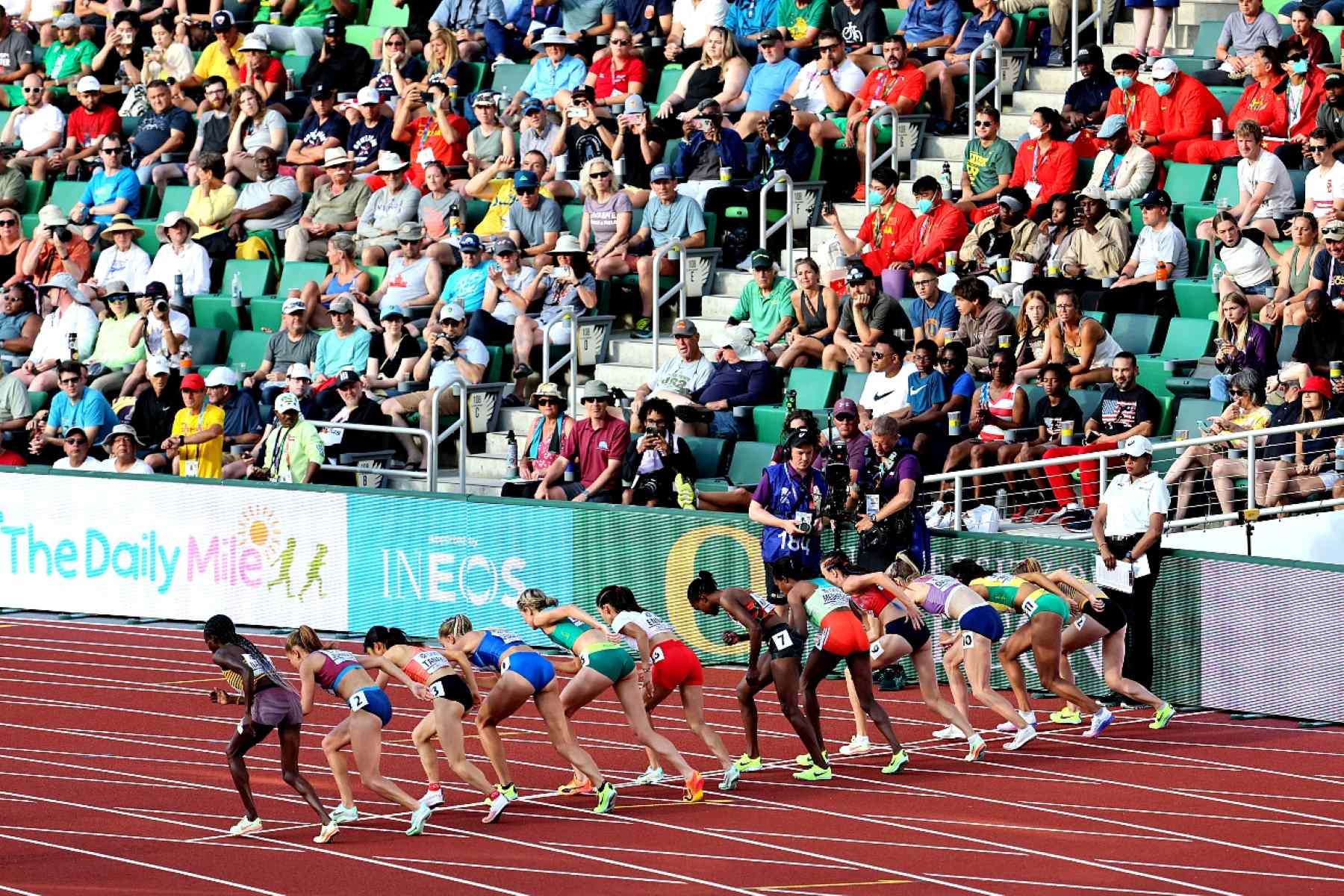

Featured
How Far Is 400 Meters On A Treadmill
Modified: January 2, 2024
Discover how far 400 meters is on a treadmill and get featured with our tips and tricks to maximize your workout
Introduction
When it comes to fitness and exercise, treadmills have become a popular choice for many people. They provide a convenient and efficient way to get a cardiovascular workout without having to leave the comfort of your home or go to the gym. However, if you are new to using a treadmill, you might be curious about how distance is measured on this particular machine.
In this article, we will delve into the topic of understanding distance on a treadmill and specifically focus on measuring 400 meters. Whether you are a beginner or an experienced runner, understanding the concept of distance on a treadmill is crucial for tracking your progress and achieving your fitness goals.
So, how exactly is distance measured on a treadmill? And how far is 400 meters on this machine? We will explore these questions and provide you with practical tips for accurately measuring the desired distance.
By the end of this article, you will have a clear understanding of how distance is measured on a treadmill, how to convert meters to distance, and the factors that can affect measurement accuracy. So, let’s dive in and unravel the mystery!
Understanding Distance on a Treadmill
Before we get into the specifics of measuring 400 meters on a treadmill, let’s first understand how distance is measured on this exercise equipment. Unlike running outdoors or on a track, where you can gauge your distance by landmarks or laps, treadmills measure distance electronically.
Treadmills use a combination of speed and time to calculate the distance you cover. When you set a specific speed on the treadmill, it determines how fast the belt moves. By multiplying the speed by the time you spend on the machine, the treadmill calculates the distance you have traveled.
The speed is usually displayed in miles per hour (mph) or kilometers per hour (km/h), depending on your preferred unit of measurement. Treadmills are equipped with sensors that track the rotations of the belt, enabling them to accurately measure the distance covered.
It’s important to note that the distance displayed on the treadmill may not be entirely precise. Factors such as belt slippage, calibration errors, and variations in running form can contribute to slight discrepancies in the distance measurement. However, most modern treadmills have built-in calibration settings that allow you to adjust the accuracy.
Now that we have a basic understanding of how distance is measured on a treadmill, let’s move on to converting meters to distance.
Converting Meters to Distance
If you’re specifically interested in measuring 400 meters on a treadmill, you’ll need to convert the meters into the appropriate distance unit used by the machine, which is typically miles or kilometers.
To convert meters to miles, divide the number of meters by 1609.34 (the number of meters in a mile). For example, to convert 400 meters to miles, you would divide 400 by 1609.34, resulting in approximately 0.2485 miles.
If you prefer kilometers, you can convert meters to kilometers by dividing the number of meters by 1000. In our example, 400 meters would be equivalent to 0.4 kilometers.
Keep in mind that treadmills usually display distance in decimal format, so you may see the converted distance rounded to a specific number of decimal places.
It’s important to note that the accuracy of distance conversion may vary slightly depending on the specific treadmill and its calibration settings. If precision is important to you, consider using the built-in calibration feature or consulting the manufacturer’s instructions to ensure accurate distance measurement.
Now that we know how to convert meters to distance on a treadmill, let’s explore the factors that can affect measurement accuracy.
Factors Affecting Measurement Accuracy
While treadmills provide a convenient way to measure and track distance, it’s essential to be aware of the factors that can affect measurement accuracy. Understanding these factors can help you make adjustments to ensure more precise results.
1. Belt Alignment and Tension: A properly aligned and tensioned treadmill belt is crucial for accurate distance measurement. If the belt is misaligned or too loose, it can affect the rotation and cause distance discrepancies.
2. Calibration Settings: Treadmills come with calibration settings that allow you to adjust the accuracy of distance measurement. If you notice significant deviations in the distance displayed, referring to the calibration settings and making necessary adjustments can improve accuracy.
3. Running Form and Stride Length: Your running form, stride length, and foot strike can vary from outdoor running, which can affect the measurement accuracy. Consistency in your running style and foot placement can help maintain more reliable distance measurement.
4. Surface Texture: Treadmills typically have textured belts to provide traction, but the texture can impact belt slippage and, consequently, distance measurement accuracy. Smooth-soled shoes or excessive lubrication can exacerbate belt slippage.
5. User Variability: Each individual’s running style and gait can differ, leading to variations in the number of rotations recorded by the treadmill sensors. These subtle variances can occasionally result in minor differences in distance measurement.
By being aware of these factors and taking the necessary precautions, you can minimize the chances of significant discrepancies in your distance measurements on a treadmill.
Now that we understand the factors that can affect measurement accuracy, let’s explore some tips for accurately measuring 400 meters on a treadmill.
Tips for Measuring 400 Meters on a Treadmill
Measuring 400 meters on a treadmill can be a great way to incorporate interval training or track workouts into your fitness routine. Here are some tips to help you accurately measure this distance:
1. Use the Treadmill’s Preset Programs: Many treadmills come with preset programs that allow you to select a specific distance, such as 400 meters. Utilizing these pre-programmed workouts ensures accurate measurement without the need for manual calculations.
2. Take Advantage of Interval Training Modes: Interval training modes are designed to help you change speed and incline automatically during your workout. Set the interval to correspond to 400 meters, and the treadmill will adjust the speed accordingly.
3. Manually Set the Distance: If your treadmill doesn’t have preset programs or interval training modes, you can manually set the distance to 0.2485 miles or 0.4 kilometers, which are the conversions for 400 meters.
4. Use GPS or Fitness Tracking Apps: If you have access to a GPS or fitness tracking app on your phone or smartwatch, you can track your distance outdoors and then replicate that distance on the treadmill. This can provide a more accurate measurement for your 400-meter workout.
5. Pay Attention to Time and Speed: If you prefer a more manual approach, you can calculate the amount of time it takes you to run 400 meters at your desired pace. Note the time, and then recreate it on the treadmill by adjusting the speed accordingly.
Remember, the accuracy of your measurement also depends on the calibration and accuracy of your specific treadmill. Regular maintenance and calibration can help ensure the most precise distance measurements.
By following these tips, you can confidently measure and track your progress when running 400 meters on a treadmill.
Conclusion
Measuring distance on a treadmill is a fundamental aspect of tracking your progress and achieving your fitness goals. While treadmills provide a convenient and effective way to monitor distance, understanding the intricacies of distance measurement can help ensure accurate results.
In this article, we explored how distance is measured on a treadmill and specifically focused on measuring 400 meters. We discussed the conversion of meters to miles or kilometers, factors that can affect measurement accuracy, and provided tips for accurately measuring 400 meters on a treadmill.
By understanding the technology behind treadmills and taking into consideration factors such as belt alignment, calibration settings, and running form, you can minimize discrepancies in distance measurement. Additionally, utilizing the treadmill’s preset programs, interval training modes, or manually setting the distance can help accurately measure 400 meters.
Remember to pay attention to time and speed, and if possible, utilize GPS or fitness tracking apps to replicate outdoor running distances on the treadmill for more precise measurements. Ongoing maintenance and calibration of your treadmill can also contribute to accurate distance tracking.
Now that you have a better understanding of how distance is measured on a treadmill and how to accurately measure 400 meters, you can confidently incorporate this distance into your workouts, track your progress, and reach your fitness goals.
So lace up your running shoes, hop on the treadmill, and start measuring that distance with confidence!









